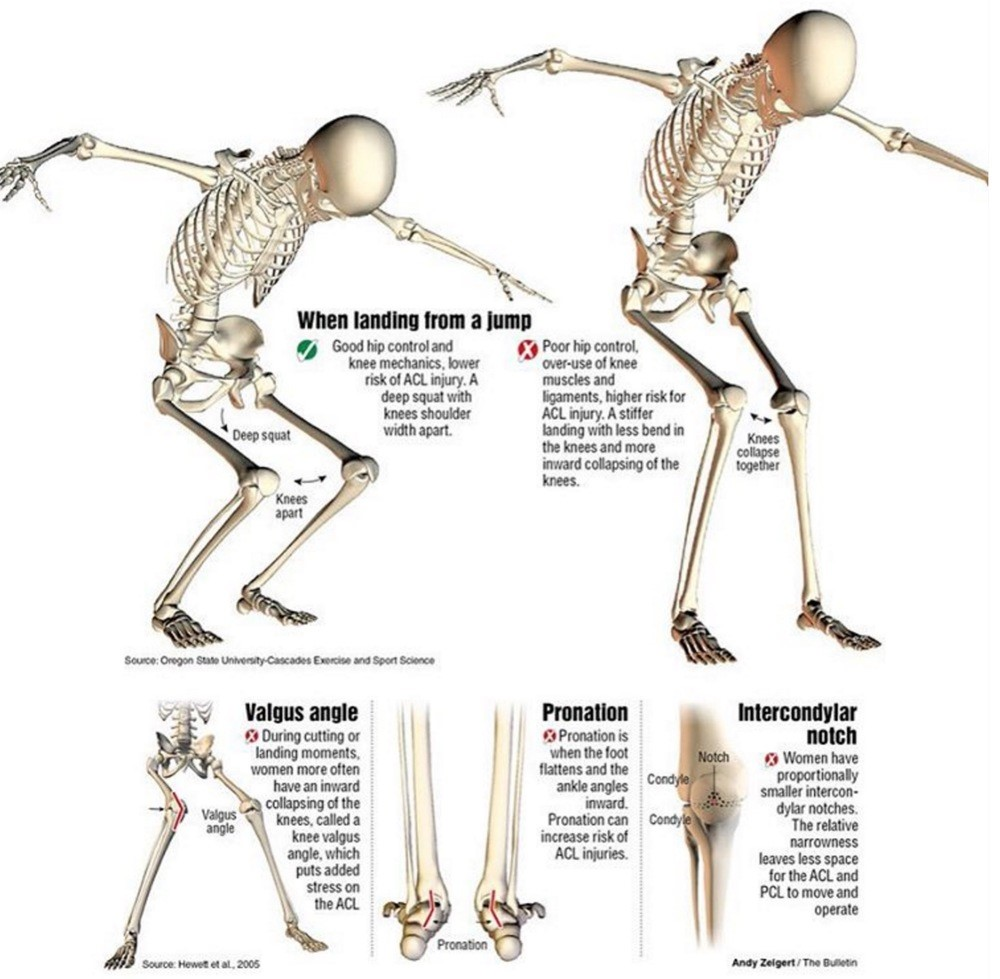ACL injury risk for women athletes has become a critical topic in sports science, drawing attention to the disparities that exist in injury rates across genders. Researchers have consistently highlighted that women athletes face a disproportionate likelihood of suffering anterior cruciate ligament (ACL) injuries, with studies revealing a 1.7 times higher injury rate compared to their male counterparts. This elevated risk is not solely attributed to biological factors such as hormonal differences or anatomical variances; rather, it is significantly influenced by social and structural inequities in women’s sports. The conversation surrounding ACL injury rates illuminates essential considerations for injury prevention for female athletes, as well as the broader implications of gender disparities in sports. By addressing these complexities, the sports community can foster a safer and more equitable environment for all athletes, irrespective of gender.
The heightened probability of ACL injuries among female athletes has emerged as a pivotal issue within the realm of sports medicine and injury prevention strategies. While some explanations have focused on biological predispositions, it is increasingly recognized that systemic factors—such as team sizes, training conditions, and resource allocation—play a significant role in these disparities. Studies consistently report that women experience higher rates of sports-related injuries, particularly ACL tears, due to a confluence of social dynamics and less optimal preparation compared to male athletes. Moreover, re-evaluating how athlete-exposures are calculated and understood offers an opportunity to enhance safety measures and training protocols. As the push for equitable treatment in athletics continues, it becomes essential to dissect these complex layers to improve outcomes for women participating in competitive sports.
Understanding the Gender Disparities in ACL Injury Rates
ACL injury rates in women athletes have been a topic of ongoing discussion within the sports science community. Research has consistently shown that women are at a significantly higher risk of suffering from ACL injuries compared to their male counterparts. Various factors contribute to this disparity, including anatomical differences and variations in training regimens. However, a growing body of literature suggests that the explanation extends beyond mere biological differences. For instance, societal and infrastructural factors like underfunding for women’s sports can lead to lower levels of training and competition exposure, two key elements that influence injury rates.
In a study conducted by Harvard’s GenderSci Lab, researchers argued that an athlete’s exposure to competitive situations plays a critical role in understanding ACL injury dynamics. This includes a call to reevaluate how exposure is measured, particularly noting that many existing models do not consider the context of team size or the distribution of training versus active play among women. This contributes not only to inflated injury rates but also obscures the structural inequalities that persist in women’s sports.
Frequently Asked Questions
Why do women athletes have higher ACL injury rates compared to men?
Women athletes experience higher ACL injury rates due to several factors, including smaller team sizes, which lead to fewer training opportunities and less conditioning. This disparity contributes to a higher risk of injuries during competition. Studies show that ACL injury rates in female athletes can be 1.7 times higher, highlighting the complexities of gender disparities in sports injuries.
What social factors contribute to ACL injury risk for women athletes?
Social factors play a significant role in the ACL injury risk for women athletes. Underfunding in women’s sports often results in fewer resources, less access to training facilities, and limited exposure to optimal conditioning practices. These inequities can elevate the likelihood of injuries, particularly when adequate training and recovery opportunities are not made available.
How do athlete-exposure metrics affect the understanding of ACL injury risk for female athletes?
Athlete-exposure metrics often overlook critical details such as individual player experience and game-time participation versus practice time. This can skew the perception of ACL injury risk for female athletes, who may face higher injury rates due to less effective practice time utilization when compared to male athletes’ more extensive training schedules.
What interventions can be implemented to lower ACL injury rates among women athletes?
To reduce ACL injury rates among women athletes, interventions should include providing equal access to training resources, increasing funding for women’s sports, and implementing specialized training that emphasizes injury prevention. Additionally, better tracking of athlete-exposure data can lead to a clearer understanding of risks and more effective preventative strategies.
How do hormonal factors relate to ACL injury risk in female athletes?
While hormonal cycles have been suggested as a potential factor in ACL injury risk for female athletes, recent research emphasizes that social and structural factors play a larger role. Studies indicate that focusing solely on biological explanations may overlook significant underlying issues such as team size and resource allocation, which ultimately affect injury rates.
What role does coaching and technical support play in ACL injury prevention for female athletes?
Coaching and technical support are crucial in ACL injury prevention for female athletes. Access to knowledgeable coaches, physical therapists, and conditioning trainers can enhance training effectiveness and help athletes develop proper techniques, thereby reducing the risk of ACL injuries. Investing in comprehensive athlete support systems is essential for improving safety and performance.
Are there specific sports where women athletes are at higher risk for ACL injuries?
Yes, sports such as soccer, basketball, and gymnastics have been identified as having higher rates of ACL injuries among women athletes. The nature of these sports, which often involve abrupt stops, jumps, and changes in direction, increases the risk for ACL tears, especially in the context of unequal training conditions and resource availability.
What changes need to be made in sports science to address gender disparities in ACL injury research?
Sports science needs to evolve by incorporating gender-specific factors in injury research. This includes developing metrics that accurately reflect individual athlete exposure, separating game time from practice time, and addressing structural inequities in training. A more nuanced understanding of these dynamics can lead to more effective interventions to mitigate ACL injury risk among women athletes.
| Aspect | Men | Women |
|---|---|---|
| Roster size-based Athlete Exposures (AEs) | 28 | 25 |
| Participant-based AEs | 19 | 17 |
| Player-hours | 6 | 6 |
| Injury rate per 100 roster-based AEs | 3.6 | 4.0 |
| Injury rate per 100 participant-based AEs | 5.3 | 5.9 |
| Injury rate per 100 player-hours | 16.7 | 16.7 |
| Injury risk per team member | 0.036 | 0.040 |
| Injury risk per participant | 0.053 | 0.059 |
Summary
ACL injury risk for women athletes is a significant concern, as recent research reveals that these risks are influenced by social factors rather than being solely biological. Women’s disproportionately high rates of ACL injuries can be attributed to their participation in smaller teams, lower training intensities compared to men, and systemic underfunding of women’s sports. By addressing these social inequities and enhancing metrics for calculating injury risks, we can better understand and ultimately reduce the ACL injury rates in female athletes. Such changes are critical for ensuring their safety and longevity in sports.








